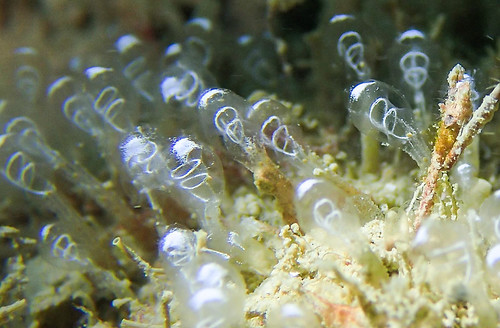Small World, Big Start
 January 11, 2017
January 11, 2017

With reefs wrapped around a pair of islands that measure less than a square kilometre, Pulau Hantu is not a big place by any measure. Regular divers know that size is no judge of the diversity of this little marine treasure trove. In fact, the diversity of our islands is disproportionate to its size! Renowned macro enthusiast, Chay Hoon, started her New Year in the waters of Pulau Hantu, and astounded her buddies with her rich and rare finds! We share some of her finds in this blog post! Above: Sea slug, Siphopteron quadrispinosum, about 2mm. Photographs by Toh Chay Hoon.

This Goniodoris nudibranch was just about 3mm!




Clockwise from top: A tiny nudibranch, Goniodoridella savignyi, just 2mm in length; a gorgeous Tambja nudibranch with its neon green body and midnight blue rhinophores; the colourful Hypselodoris bollandi nudibranch, and the nudibranch Flabellina rubrolineata.

A close look at a colony of ascidians, aka. sea squirts. Although they are soft and boneless, ascidians are not invertebrates, but are primitive chordates, the phylum to which humans and all back-boned animals belong [1]!

Sea pens are animals that live on the sea floor, but like coral, they themselves are habitats for other cryptic creatures. Shrimp, crabs, and other predatory invertebrates can be found hiding in the gills of these creatures!

A basket star twirled tightly around a gorgonian coral. They are most active at night! While they are predators themselves, they would also make a tasty treat for an opportunistic fish!

A small cuttlefish tries to remain hidden by keeping still and sticking close to a sponge.

Not a great shot, but what a cool find! What is this? It’s tiny, just 3mm. It’s some kind of sea slug. But is it Stiliger sp. or Kerryclarkella sp.?

Not all encounters were tiny! Although this Carpet eel blenny was definitely cryptic with most of its body tucked into the reef!

A Noble volute half buried in the sand.

Back to the small stuff, this beautiful Doto sp. nudibranch was just about 5mm.


Scenes from the reef: A massive barrel sponge and a damselfish with a crinoid. Like the sea pens above, sponges and crinoids are animals that are themselves habitats for other creatures. It may seem odd and bizarre, but we too are habitats for a massive variety of micro organisms that live on our skin and in our guts! We humans depend on these micro organisms to be healthy – think probiotics! Similarly, many reef organisms depend on relationships with other organisms to survive!

While surfacing from a dive, divers shared a precious moment with one of Pulau Hantu’s special reptiles – a Yellow-lipped sea krait! Despite being one of the most venomous animals on the planet, these sea kraits are quite happy to mind their own business while foraging in the reefs, and peacefully share the reef with divers. Although it is an aquatic snake, it still needs safe and natural coasts to build nests and lay its eggs. So we need to protect our shores to keep marine life alive! How can you protect our shores? Share your discoveries and experiences with others, or become a volunteer! Our shores and reef need us! If we enjoy them, we need to act to protect them or risk losing them forever. Visit the link above to find out how you can make a difference, even if you don’t dive!


 Posted in
Posted in 



 content rss
content rss
January 15th, 2017 at 5:21 pm
What camera you use? What lens you use? The housing LEH?